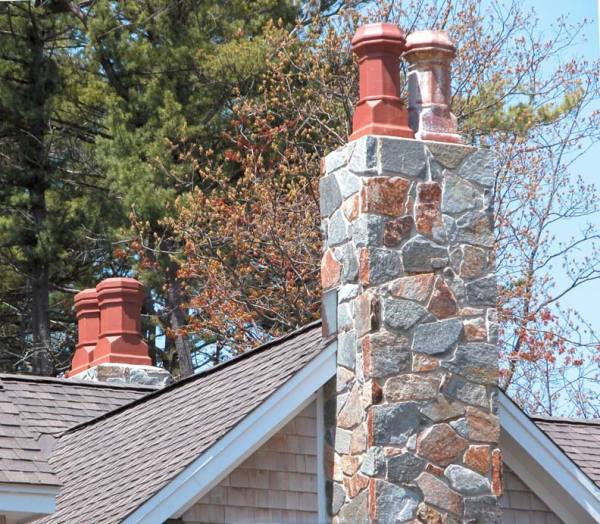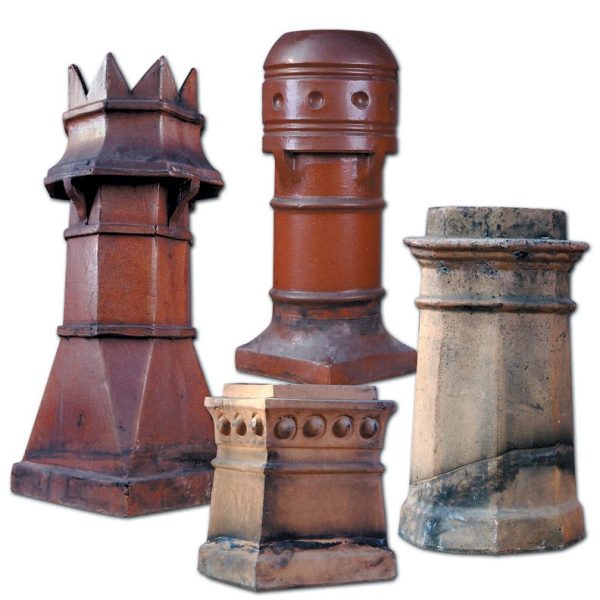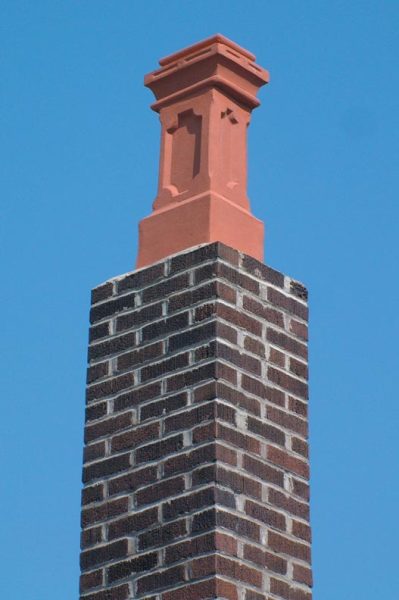
Pots play up multiple flues and are often varied in style on different chimneys. (Photo: The Chimney Pot Shoppe)
By necessity typically the highest point of the house, the chimney top is not only the outdoor exit of the flue but, in many houses, also an important stylistic pinnacle. Many chimneys take advantage of this prominence by finishing in one of the most creative old-house features: the chimney pot.
Despite the long history and growing popularity of chimney pots, serious students and restorers of these fanciful features will be hard pressed to find a wealth of historical background about them. What information is available, however, can be found not with the right search engine but in few choice chapters of some classic construction books.
North American chimney pots clearly seem to be European in origin. They were used in many temperate-winter countries from England to Italy where hearths for coal or other slow-burning fires were common. Though they surely crossed the Atlantic with English and French settlers (Quebec City claims its share of chimney pots), the earliest popularizer of the chimney pot in America was—who else?—the prolific Andrew Jackson Downing in the 19th century. Downing’s affection for pots was a natural outgrowth of his passion for Gothic Revival architecture—the style he saw as ideally suited to a modest, cozy house—and in pots he found the fitting capstone to their picturesque quality.

Inventive pot forms may also be functional, incorporating rain guards (top) and smoke vents (left). (Photo: The Chimney Pot Shoppe)
In Cottage Residences (1842), Downing says, “One of the most characteristic and beautiful features in rural Gothic architecture is the ornamental chimney shaft, sometimes rising singly, sometimes in clusters from the roof—but frequently wreathed and molded in the most picturesque manner.” Windows and chimney tops he notes, “are two of the most essential and characteristic features of dwelling houses…to which decoration should always be first applied rather than to any less essential or superadded features.”
Chimney tops, he notes, “should always be rendered ornamental, both because strongly expressive of comfort, no house being tolerable in a cold climate without fires, and on account of their occupying the highest part of the building, and therefore being most likely to strike the eye agreeably.” Among the house plans offered in his books, Downing suggests ordering chimney tops of terracotta or iron as an effective way to enhance the picturesque appearance of an otherwise small or modestly built dwelling.
For one design—a cottage “in the rural Gothic or English manner”—he made a special point of spec’ing just the right pots (some at 4 1/2′ tall), noting that they could be imported from England.

Pots have long been used to improve draft by extending chimney height. Dimensions should match the flue according to suppliers’ recommendations. (Photo: Superior Clay Tile)
In the latter half of the 19th century as the Gothic Revival waned, chimney pots lost some of their stylistic appeal on houses, giving way to the balloon brickwork often seen on high-style Queen Anne chimneys. They remained functional, though, for the increasing use of coal in heating, where their tapered forms improved flue draft. In fact, they were often used far out of sight on the chimneys of row houses that proliferated through growing cities, where clumps of pots helped keep the multiple flues in each chimney from back-drafting one to another.
Chimney pots gained new cachet in the early 20th century with the resurgent influence of English architecture and picturesque houses. Before World War I, some Arts & Crafts houses built on the East Coast made use of those that took their cues from English models. In the 1920s, as various interpretations of Tudor and English Revival houses became one of the mainstream forms of the suburban house, pots again came into play as evocative European ornament on an otherwise thoroughly modern, American house.
The 1924 advice offered to builders of the day, as summarized from the ever-practical International Correspondence School series, still holds true today: “Instead of flat caps, chimney pots made of terracotta are sometimes used. These pots form a picturesque and ornamental finish to a chimney and are made in many different forms, which are kept in stock by dealers. The pots are set so as to cover the flue lining in the chimney, one pot for each flue. A strong cement mortar is used in setting the pots, and it is graded away from the pots to the outside of the chimney so as to form a wash. Simple pots may be round and circular in plan with graceful lines. More elaborate pots are octagonal. Very large elaborate designs have outlets for smoke in the sides as well as the top.”







